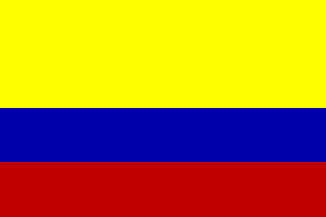The Columbian flag is made up of three horizontal stripes of yellow, blue and red; the yellow stripe being twice the width of the smaller red and blue sections. You will find a very good image of this flag at the following page - www.classbrain.com/art_cr/publish/columbia_flag.shtml This flag was adopted by Columbia in 1819.
It is believed that the meaning of the Columbian flag is related to the victory against Spain for independence. Although the exact interpretations of how each colour related to this accomplishment are frequently disputed. It is common for a country to design their flag with certain colours, stripes, or shapes which relate to specific meanings or to represent historical events; flags are often adapted to represent new messages or to incorporate an additional element.
The Columbian flag is very similar to the flag of Ecuador, which again has the same three stripes. The only difference being that the flag of Ecuador also has a coat of arms in the centre of the flag. You can view an example of this at - www.farmstaysecuador.org/ecuador-flag.html This flag was adopted in 1860; so over 40 years after that of the Columbian flag.
Flying a flag is considered symbolic and signifies a pride for a certain country. Flags can also represent ownership; this could be ownership of anything from a country to a house (some families have their own coat of arms which can be made into a flag). Flying a flag can make people feel united and strong.
It is believed that the meaning of the Columbian flag is related to the victory against Spain for independence. Although the exact interpretations of how each colour related to this accomplishment are frequently disputed. It is common for a country to design their flag with certain colours, stripes, or shapes which relate to specific meanings or to represent historical events; flags are often adapted to represent new messages or to incorporate an additional element.
The Columbian flag is very similar to the flag of Ecuador, which again has the same three stripes. The only difference being that the flag of Ecuador also has a coat of arms in the centre of the flag. You can view an example of this at - www.farmstaysecuador.org/ecuador-flag.html This flag was adopted in 1860; so over 40 years after that of the Columbian flag.
Flying a flag is considered symbolic and signifies a pride for a certain country. Flags can also represent ownership; this could be ownership of anything from a country to a house (some families have their own coat of arms which can be made into a flag). Flying a flag can make people feel united and strong.
